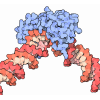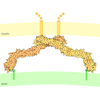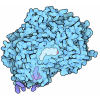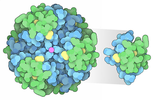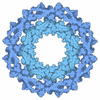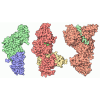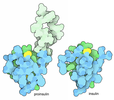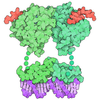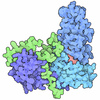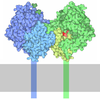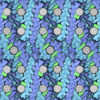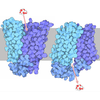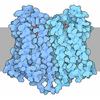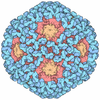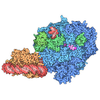[English] 日本語
 Yorodumi
Yorodumi- PDB-9jwj: Structure of Human HDAC2 in complex with inhibitor N-(2-amino-5-(... -
+ Open data
Open data
- Basic information
Basic information
| Entry | Database: PDB / ID: 9jwj | ||||||
|---|---|---|---|---|---|---|---|
| Title | Structure of Human HDAC2 in complex with inhibitor N-(2-amino-5-(furan-2-yl)phenyl)-4-(1-((phenylsulfonyl)methyl)-1H-1,2,3-triazol-4-yl)benzamid | ||||||
 Components Components | Histone deacetylase 2 | ||||||
 Keywords Keywords | TRANSCRIPTION / Histone deacetylase 2 | ||||||
| Function / homology |  Function and homology information Function and homology informationpositive regulation of male mating behavior / protein de-2-hydroxyisobutyrylase activity / protein lysine delactylase activity / negative regulation of dendritic spine development / p75NTR negatively regulates cell cycle via SC1 / epidermal cell differentiation / histone decrotonylase activity / fungiform papilla formation / NuRD complex / positive regulation of interleukin-1 production ...positive regulation of male mating behavior / protein de-2-hydroxyisobutyrylase activity / protein lysine delactylase activity / negative regulation of dendritic spine development / p75NTR negatively regulates cell cycle via SC1 / epidermal cell differentiation / histone decrotonylase activity / fungiform papilla formation / NuRD complex / positive regulation of interleukin-1 production / regulation of cell fate specification / behavioral response to ethanol / EGR2 and SOX10-mediated initiation of Schwann cell myelination / negative regulation of transcription by competitive promoter binding / negative regulation of stem cell population maintenance / histone deacetylase activity, hydrolytic mechanism / ESC/E(Z) complex / histone deacetylase / regulation of stem cell differentiation / cardiac muscle hypertrophy / cellular response to dopamine / STAT3 nuclear events downstream of ALK signaling / response to caffeine / protein lysine deacetylase activity / Hydrolases; Acting on carbon-nitrogen bonds, other than peptide bonds; In linear amides / histone deacetylase activity / embryonic digit morphogenesis / positive regulation of intracellular estrogen receptor signaling pathway / Notch-HLH transcription pathway / Sin3-type complex / histone deacetylase complex / odontogenesis of dentin-containing tooth / eyelid development in camera-type eye / positive regulation of stem cell population maintenance / dendrite development / response to amyloid-beta / RNA Polymerase I Transcription Initiation / positive regulation of oligodendrocyte differentiation / positive regulation of proteolysis / Regulation of MECP2 expression and activity / progesterone receptor signaling pathway / response to hyperoxia / hair follicle placode formation / NF-kappaB binding / FOXO-mediated transcription of oxidative stress, metabolic and neuronal genes / cellular response to transforming growth factor beta stimulus / positive regulation of epithelial to mesenchymal transition / Transcriptional regulation of brown and beige adipocyte differentiation by EBF2 / MECP2 regulates neuronal receptors and channels / Regulation of TP53 Activity through Acetylation / cellular response to retinoic acid / heat shock protein binding / negative regulation of cell migration / response to amphetamine / SUMOylation of chromatin organization proteins / Regulation of PTEN gene transcription / ERCC6 (CSB) and EHMT2 (G9a) positively regulate rRNA expression / transcription coregulator binding / Regulation of endogenous retroelements by KRAB-ZFP proteins / response to nicotine / response to cocaine / HDACs deacetylate histones / Regulation of endogenous retroelements by Piwi-interacting RNAs (piRNAs) / promoter-specific chromatin binding / circadian regulation of gene expression / negative regulation of transforming growth factor beta receptor signaling pathway / NoRC negatively regulates rRNA expression / protein modification process / NOTCH1 Intracellular Domain Regulates Transcription / Constitutive Signaling by NOTCH1 PEST Domain Mutants / Constitutive Signaling by NOTCH1 HD+PEST Domain Mutants / histone deacetylase binding / cellular response to hydrogen peroxide / positive regulation of tumor necrosis factor production / heterochromatin formation / negative regulation of neuron projection development / cellular response to heat / Factors involved in megakaryocyte development and platelet production / histone binding / response to lipopolysaccharide / Potential therapeutics for SARS / RNA polymerase II-specific DNA-binding transcription factor binding / chromosome, telomeric region / chromatin remodeling / response to xenobiotic stimulus / negative regulation of DNA-templated transcription / positive regulation of cell population proliferation / chromatin binding / negative regulation of apoptotic process / chromatin / positive regulation of DNA-templated transcription / enzyme binding / negative regulation of transcription by RNA polymerase II / positive regulation of transcription by RNA polymerase II / protein-containing complex / RNA binding / nucleoplasm / nucleus / cytoplasm Similarity search - Function | ||||||
| Biological species |  Homo sapiens (human) Homo sapiens (human) | ||||||
| Method |  X-RAY DIFFRACTION / X-RAY DIFFRACTION /  SYNCHROTRON / SYNCHROTRON /  MOLECULAR REPLACEMENT / Resolution: 1.78 Å MOLECULAR REPLACEMENT / Resolution: 1.78 Å | ||||||
 Authors Authors | Tojo, T. / Itoh, Y. / Kurohara, T. / Li, Y. / Singh, R. / Narozny, R. / Wiel, A. / Miyake, Y. / Yamashita, Y. / Kusakabe, K. ...Tojo, T. / Itoh, Y. / Kurohara, T. / Li, Y. / Singh, R. / Narozny, R. / Wiel, A. / Miyake, Y. / Yamashita, Y. / Kusakabe, K. / Uchida, S. / Suzuki, T. | ||||||
| Funding support | 1items
| ||||||
 Citation Citation |  Journal: To Be Published Journal: To Be PublishedTitle: Discovery of an HDAC2-selective inhibitor based on enzyme-inhibitor binding thermodynamics and kinetics, and its potential as a therapeutic drug for neurological disorders Authors: Tojo, T. / Itoh, Y. / Kurohara, T. / Li, Y. / Singh, R. / Narozny, R. / Wiel, A. / Miyake, Y. / Yamashita, Y. / Kusakabe, K. / Uchida, S. / Suzuki, T. | ||||||
| History |
|
- Structure visualization
Structure visualization
| Structure viewer | Molecule:  Molmil Molmil Jmol/JSmol Jmol/JSmol |
|---|
- Downloads & links
Downloads & links
- Download
Download
| PDBx/mmCIF format |  9jwj.cif.gz 9jwj.cif.gz | 266.4 KB | Display |  PDBx/mmCIF format PDBx/mmCIF format |
|---|---|---|---|---|
| PDB format |  pdb9jwj.ent.gz pdb9jwj.ent.gz | Display |  PDB format PDB format | |
| PDBx/mmJSON format |  9jwj.json.gz 9jwj.json.gz | Tree view |  PDBx/mmJSON format PDBx/mmJSON format | |
| Others |  Other downloads Other downloads |
-Validation report
| Summary document |  9jwj_validation.pdf.gz 9jwj_validation.pdf.gz | 1.2 MB | Display |  wwPDB validaton report wwPDB validaton report |
|---|---|---|---|---|
| Full document |  9jwj_full_validation.pdf.gz 9jwj_full_validation.pdf.gz | 1.2 MB | Display | |
| Data in XML |  9jwj_validation.xml.gz 9jwj_validation.xml.gz | 60.1 KB | Display | |
| Data in CIF |  9jwj_validation.cif.gz 9jwj_validation.cif.gz | 81.9 KB | Display | |
| Arichive directory |  https://data.pdbj.org/pub/pdb/validation_reports/jw/9jwj https://data.pdbj.org/pub/pdb/validation_reports/jw/9jwj ftp://data.pdbj.org/pub/pdb/validation_reports/jw/9jwj ftp://data.pdbj.org/pub/pdb/validation_reports/jw/9jwj | HTTPS FTP |
-Related structure data
| Related structure data |  9jv3C  9k0gC  4ly1S S: Starting model for refinement C: citing same article ( |
|---|---|
| Similar structure data | Similarity search - Function & homology  F&H Search F&H Search |
- Links
Links
- Assembly
Assembly
| Deposited unit | 
| ||||||||
|---|---|---|---|---|---|---|---|---|---|
| 1 |
| ||||||||
| Unit cell |
|
- Components
Components
-Protein , 1 types, 3 molecules ABC
| #1: Protein | Mass: 45997.965 Da / Num. of mol.: 3 Source method: isolated from a genetically manipulated source Source: (gene. exp.)  Homo sapiens (human) / Gene: HDAC2 / Production host: Homo sapiens (human) / Gene: HDAC2 / Production host:  References: UniProt: Q92769, histone deacetylase, Hydrolases; Acting on carbon-nitrogen bonds, other than peptide bonds; In linear amides |
|---|
-Non-polymers , 9 types, 764 molecules 

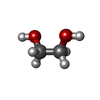
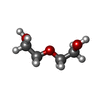
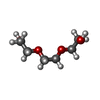
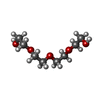
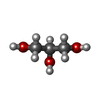
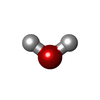







| #2: Chemical | | #3: Chemical | ChemComp-CA / #4: Chemical | Mass: 499.541 Da / Num. of mol.: 3 / Source method: obtained synthetically / Formula: C26H21N5O4S / Feature type: SUBJECT OF INVESTIGATION #5: Chemical | ChemComp-EDO / #6: Chemical | ChemComp-PEG / #7: Chemical | ChemComp-PGE / | #8: Chemical | #9: Chemical | ChemComp-GOL / | #10: Water | ChemComp-HOH / | |
|---|
-Details
| Has ligand of interest | Y |
|---|---|
| Has protein modification | N |
-Experimental details
-Experiment
| Experiment | Method:  X-RAY DIFFRACTION / Number of used crystals: 1 X-RAY DIFFRACTION / Number of used crystals: 1 |
|---|
- Sample preparation
Sample preparation
| Crystal | Density Matthews: 2.3 Å3/Da / Density % sol: 46.53 % |
|---|---|
| Crystal grow | Temperature: 291 K / Method: vapor diffusion / Details: 0.1 M CHES pH 9.5, 35-38% (v/v) PEG 600 |
-Data collection
| Diffraction | Mean temperature: 100 K / Serial crystal experiment: N |
|---|---|
| Diffraction source | Source:  SYNCHROTRON / Site: SYNCHROTRON / Site:  SSRF SSRF  / Beamline: BL17U1 / Wavelength: 1 Å / Beamline: BL17U1 / Wavelength: 1 Å |
| Detector | Type: ADSC QUANTUM 315r / Detector: CCD / Date: Jul 7, 2018 |
| Radiation | Protocol: SINGLE WAVELENGTH / Monochromatic (M) / Laue (L): M / Scattering type: x-ray |
| Radiation wavelength | Wavelength: 1 Å / Relative weight: 1 |
| Reflection | Resolution: 1.78→50 Å / Num. obs: 110377 / % possible obs: 91.2 % / Redundancy: 4.9 % / CC1/2: 0.997 / Rmerge(I) obs: 0.078 / Rpim(I) all: 0.038 / Rrim(I) all: 0.088 / Net I/σ(I): 10.8 |
| Reflection shell | Resolution: 1.78→1.88 Å / % possible obs: 91.8 % / Redundancy: 4.8 % / Rmerge(I) obs: 0.611 / Num. measured all: 77155 / Num. unique obs: 16112 / CC1/2: 0.805 / Rpim(I) all: 0.287 / Rrim(I) all: 0.679 / Net I/σ(I) obs: 3.5 |
- Processing
Processing
| Software |
| ||||||||||||||||||||||||||||||||||||||||||||||||||||||||||||||||||||||||||||||||||||||||||||||||||||||||||||||||||||||||||||||||||||||||||||||||||||||||||||||||||||||||||||||||||||||
|---|---|---|---|---|---|---|---|---|---|---|---|---|---|---|---|---|---|---|---|---|---|---|---|---|---|---|---|---|---|---|---|---|---|---|---|---|---|---|---|---|---|---|---|---|---|---|---|---|---|---|---|---|---|---|---|---|---|---|---|---|---|---|---|---|---|---|---|---|---|---|---|---|---|---|---|---|---|---|---|---|---|---|---|---|---|---|---|---|---|---|---|---|---|---|---|---|---|---|---|---|---|---|---|---|---|---|---|---|---|---|---|---|---|---|---|---|---|---|---|---|---|---|---|---|---|---|---|---|---|---|---|---|---|---|---|---|---|---|---|---|---|---|---|---|---|---|---|---|---|---|---|---|---|---|---|---|---|---|---|---|---|---|---|---|---|---|---|---|---|---|---|---|---|---|---|---|---|---|---|---|---|---|---|
| Refinement | Method to determine structure:  MOLECULAR REPLACEMENT MOLECULAR REPLACEMENTStarting model: 4LY1 Resolution: 1.78→50 Å / Cor.coef. Fo:Fc: 0.971 / Cor.coef. Fo:Fc free: 0.955 / SU B: 2.252 / SU ML: 0.071 / Cross valid method: THROUGHOUT / ESU R: 0.12 / ESU R Free: 0.118 / Stereochemistry target values: MAXIMUM LIKELIHOOD / Details: HYDROGENS HAVE BEEN USED IF PRESENT IN THE INPUT
| ||||||||||||||||||||||||||||||||||||||||||||||||||||||||||||||||||||||||||||||||||||||||||||||||||||||||||||||||||||||||||||||||||||||||||||||||||||||||||||||||||||||||||||||||||||||
| Solvent computation | Ion probe radii: 0.8 Å / Shrinkage radii: 0.8 Å / VDW probe radii: 1.4 Å / Solvent model: BABINET MODEL WITH MASK | ||||||||||||||||||||||||||||||||||||||||||||||||||||||||||||||||||||||||||||||||||||||||||||||||||||||||||||||||||||||||||||||||||||||||||||||||||||||||||||||||||||||||||||||||||||||
| Displacement parameters | Biso mean: 30.272 Å2
| ||||||||||||||||||||||||||||||||||||||||||||||||||||||||||||||||||||||||||||||||||||||||||||||||||||||||||||||||||||||||||||||||||||||||||||||||||||||||||||||||||||||||||||||||||||||
| Refinement step | Cycle: 1 / Resolution: 1.78→50 Å
| ||||||||||||||||||||||||||||||||||||||||||||||||||||||||||||||||||||||||||||||||||||||||||||||||||||||||||||||||||||||||||||||||||||||||||||||||||||||||||||||||||||||||||||||||||||||
| Refine LS restraints |
|
 Movie
Movie Controller
Controller


 PDBj
PDBj
